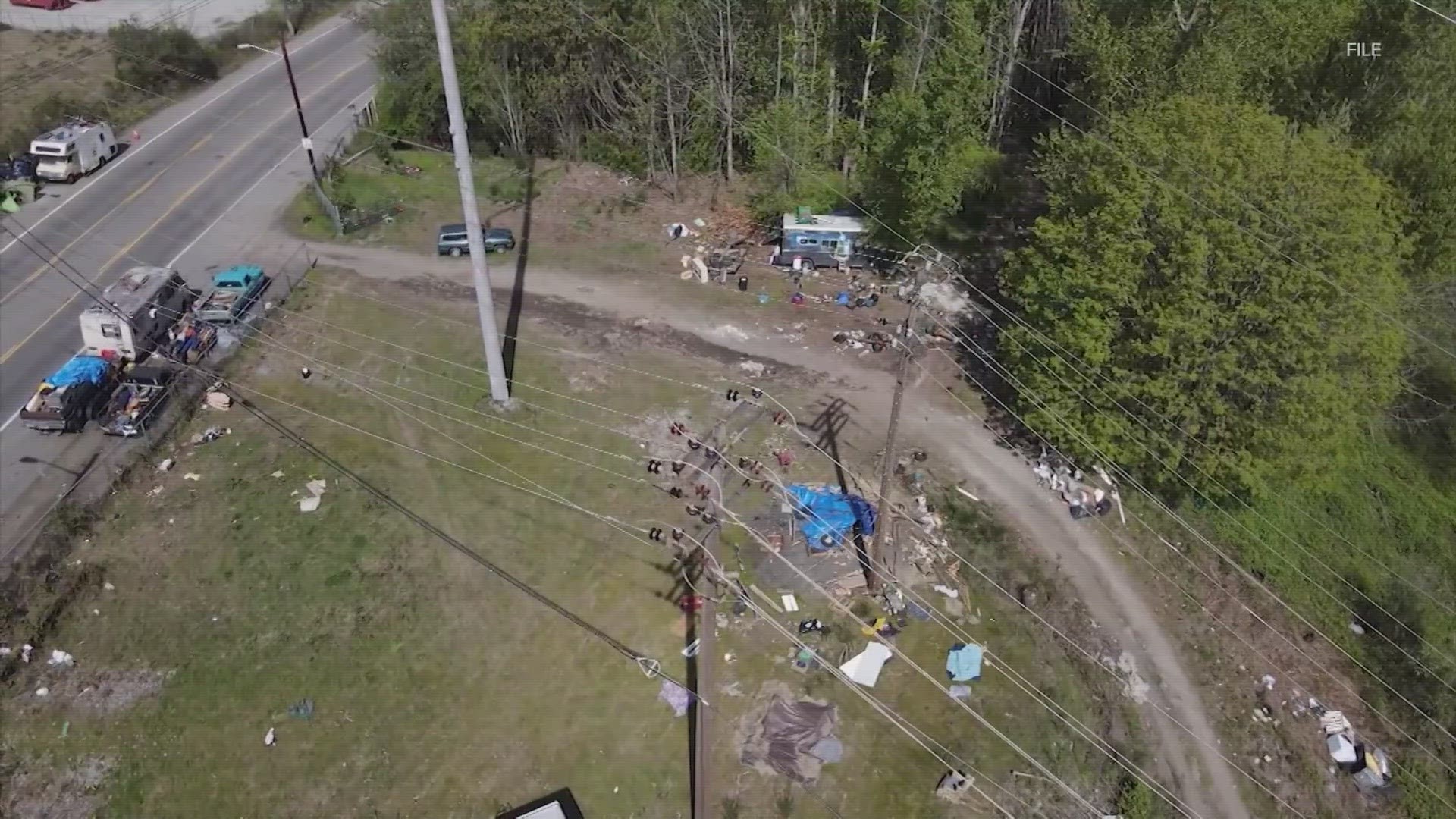SEATTLE — Officials with the Washington State Department of Transportation (WSDOT) along with its community partners spoke and answered questions Tuesday night for two hours about plans to clean up the encampment situated between Myers Way South & State Route 509. The meeting took place at SHAG Arrowhead Gardens, a senior living community.
For months, those living there have complained to local and state officials about the problems that have come with living so close to a sprawling homeless encampment: cars being broken into and stolen, frequent gunshots, homes being broken into and threats of violence. Several residents told KING 5 they are afraid to go outside after dark.
The breaking point for many people came in May when Seattle Police announced it was investigating a homicide at the camp. That case is still unsolved at this time.
The WSDOT is aware of all these issues. For months, KING 5 has been told the state agency is coming up with a plan, but it was more difficult to address because of its location. Before the WSDOT can come in and clean up the site, they must partner with community groups to offer those in the encampment shelter, a place to store their belongings and other resources.
Brian Nielsen, WSDOT administrator for the NW Region, led off the meeting by explaining this cleanup is taking place under the state's Right of Way Safety Initiative. The law was passed in 2022 to address an increase in safety issues along state highways. The WSDOT, along with the Department of Commerce, and Washington State Patrol partner with numerous local governments and non-profit partners.
Simply put, more money can now be allocated to address homeless encampments that are dangerously close to state highways like the Myers Way S. encampment. $50 million has been allocated to King County. Examples of how some of that money has been used are below.
According to Nielsen, eight other sites in King County have been cleaned up under this initiative. Myers Way is the ninth site. As of May, 324 people accepted housing under the initiative. Of those, 254 remain in that housing.
In King County alone, it's estimated there are more than 900 encampments on WSDOT property. Nielsen said the availability of housing is an ongoing issue. There's not enough housing for those who are unhoused.
Nielsen went on to explain that under the state law, they must transition those living in the encampments to safe housing that's better than where they were living, giving them the resources they need to succeed.
A definitive timeline for when this work will be completed was not given. Nielsen acknowledged that is not what people wanted to hear, but he wants people to trust in the process.
"Our initiative takes time," Nielsen said. "The intensive outreach approach does work. We've seen a 90% acceptance of services because we take the time to get to know the people on site and know what their specific needs are."
Nielsen said that approach keeps a majority of the people they serve in housing.
Lisa Daugaard, co-executive director of Purpose. Dignity. Action. (PDA) also spoke at the meeting. She explained how PDA's approach of gaining the trust of those in encampments has led to success. Forty-eight people, according to Daugaard, in the Myers Way encampment have agreed to go to housing once it's available. Daugaard explained how a delay in a housing site opening has prevented them from moving people sooner. She expects that site to open up within the next month.
Nichole Alexander, also with PDA, spoke at the meeting about the trust-building process to get those living in encampments to agree to receive services. She leads a team of people from PDA and REACH every morning, Monday through Friday, providing those in the encampment with food, water, and other resources. Daugaard said many people have come around to getting help because of the work Alexander leads. Some residents of the neighboring senior living community encouraged Alexander to keep her and her team safe as they go into the encampment, fearing they could be attacked. Alexander assured those in the audience they all take the necessary precautions.
Lt. Dorothy Kim, who received applause, and City Councilor Lisa Herbold spoke at the meeting. Kim encouraged residents to continue calling 911 any time they felt unsafe. Herbold sang the praises of the approach being used at this encampment, citing other successes cleaned up with the same method.
Residents listened closely because this encampment has disrupted their lives. Many of them are seniors who are vulnerable. Hearing gunshots triggers PTSD. Being afraid to come out of their homes is not how many of them envisioned living out their golden years. While the questions started off pleasant, they became more blunt as the Q&A went on. One man yelled about all the care those living in the encampment are receiving, describing it as "rolling out the red carpet" for them.
The WSDOT and the community partners answered all the questions diligently, explaining that they know it's not okay what's happening at the Myers Way encampment. It's illegal. However, they believe their approach will prevent another encampment from springing up at the same site.
Barriers will be placed on Wednesday by WSDOT to prevent access to its property from Myers Way South.
For previous reporting on this story:

